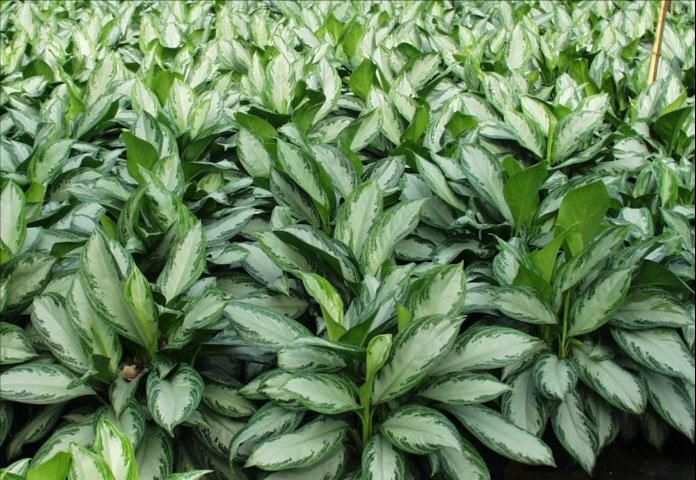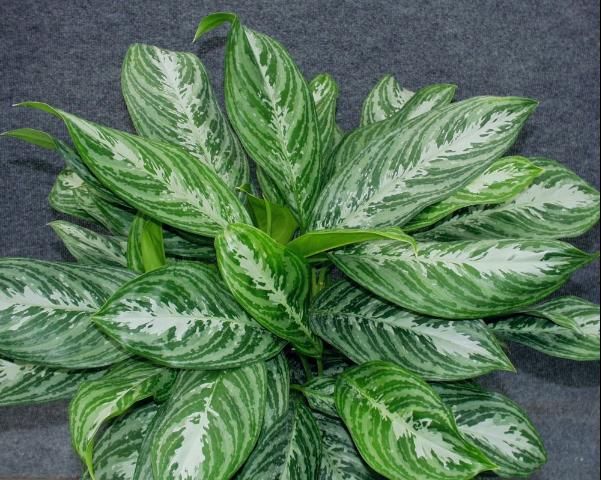Origin
Because they readily adapt to the low light and low relative humidity levels encountered in interior conditions, Aglaonema cultivars, popularly known as Chinese evergreens, have been valued ornamental foliage plants for decades. Originally, Aglaonema cultivars (family Araceae) were introduced into the tropical foliage industry directly from the wild out of their native habitats in Southeast Asia. Until the 1980s, new varieties arose via spontaneous mutations, or "sports," selected from established cultivars in commercial production. In the past 20 years, control of flowering and the development of pollination techniques have led to the hybridization of many new Aglaonema cultivars.
Tissue culture is used by the commercial plant industry to speed the plant propagation process. This method was employed to propagate Aglaonema 'Silver Bay' stock plants for further propagation by tip cuttings. 'Silver Bay' (Figure 1) was one of the first Aglaonema interspecific hybrids developed by the Foliage Plant Breeding Program at the UF/IFAS Mid-Florida Research and Education Center (MREC) in Apopka. 'Silver Bay' is a very popular Aglaonema cultivar because of its beautiful foliage, good growth habit, and excellent performance in interior conditions. Aglaonema 'Moonlight Bay' is a mutation discovered within a population of tissue-cultured Aglaonema 'Silver Bay' plants.

Credit: UF/IFAS
Description
Mature Aglaonema 'Moonlight Bay' leaves are lance shaped 11–12 cm (5–6 in.) wide, and 28–30 cm (10–12 in.) long. Leaf margins are smooth, and leaf tissue on either side of the midrib tends to be of slightly unequal widths. This results in curving or waviness of the leaf toward the narrower side. Leaves exhibit an uneven and sporadic central gray-green area that extends from each side of the midrib toward the margin (Figure 2). In some areas, this gray area is very narrow, while in others, it covers half the leaf surface from midrib to margin. Leaf margins are green and touch the lighter central area along irregular borders. The undersides of the leaves are green. The outer petiole wings are yellow-green, and these blend into the lighter yellow-green petiole center. The entire petiole near the leaf blade becomes a uniform yellow-green. The stem color ranges from dark to light yellow-green. The stem and petiole colors are not usually visible due to the clasping nature of the petiole wings that surround the stem.

Credit: UF/IFAS
Growth characteristics of Aglaonema 'Moonlight Bay' were determined using 50 newly rooted stem cuttings, each with 4–5 leaves. Plants were potted into 6 in. diameter (1.6 L) plastic pots containing a substrate of VerGro Container Mix A (Verlite Co., Tampa, FL 33610). The growth study was conducted in a greenhouse shaded to exclude 70% of sunlight, natural photoperiod, and a temperature range of 15°C–34°C (59°F–93°F). Ten plants were grown for nine months (from October 2003 until July 2004) at each of five different fertilizer levels within a completely randomized design. The five levels were derived from a mixture with a 3:1:2 ratio of nitrogen:phosphorus:potassium that was applied as a liquid drench at 100 mL per pot per week. The five mixture rates applied were equivalent to 300, 400, 500, 600, and 700 ppm of nitrogen.
Data recorded at termination of the study included canopy height, canopy width, length and width of largest leaf, number of basal shoots, and a visual quality rating, where 1 = dead, 3 = acceptable (saleable), and 5 = excellent. Data were analyzed using ANOVA procedures of the SAS program.
Aglaonema 'Moonlight Bay' reached marketable size in nine months. There were no significant differences in canopy height or width, leaf size, or basal shoot number (Table 1). Visual quality showed a significant difference, but all plants were rated as excellent or near excellent in quality. There was a slight loss of quality at the lowest and highest nutritional levels. Plants were moderately well branched, averaging approximately three basal shoots per plant.
'Moonlight Bay' plants uniformly expressed the new variegation pattern and maintained desirable ornamental characteristics, such as excellent plant form, growth habit, and vigor. 'Moonlight Bay' was subsequently selected for release through the Foliage Plant Breeding Program at UF/IFAS MREC.
Availability
Aglaonema 'Moonlight Bay' is intended for commercial producers growing finished plants in 6 in. (1.6 L) or 8 in. (3.9 L) containers. A patent application has been submitted to the United States Patent and Trademark Office. Plant patent rights have been assigned to the Florida Foundation Seed Producers, Inc., PO Box 309, Greenwood, FL 32443. Plants for research purposes may be obtained directly from the author.
Additional Information
Henny, R. J. 1983. "Flowering of Aglaonema commutatum 'Treubii' following treatment with gibberellic acid." HortScience 18:374.
Henny, R. J. 1985. "In vivo pollen germination of Aglaonema affected by relative humidity." HortScience 20:142–143.
Henny, R. J. and J. Chen. 2008. "'Moonlight Bay' Aglaonema." HortScience 43(5): 1598-1599.
Henny, R. J., R. T. Poole, and C. A. Conover. 1992. "'Silver Bay' Aglaonema." HortScience 27:1238.